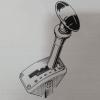Engine Starts Only After I Stop Cranking
#16

Posted 07 December 2023 - 07:19 PM
#17

Posted 07 December 2023 - 10:41 PM
68+86, not ballasts. 3 ohms across the coil and 12v switched feed to coil+.
Then please check the battery voltage while cranking (after charging it). Under 9.6v is no good and will struggle to start. If everything is correctly wired (no ballast resistor) then you should be getting close to the battery voltage at the coil (when cranking).
Edited by 68+86auto, 07 December 2023 - 10:44 PM.
#18

Posted 08 December 2023 - 05:31 AM
The Electronics in the module won't work under 9.0 Volts. Under that figure, it's as good as not even having the Ignition on at all.
Can I suggest doing a Volt-drop check here ? You'll need a set of croc clips for your multimeter so you can hook it up and be hands free with it to do this. You might also need some help unless your meter has a memory or record function.
To do this test, connect the meter across each connection in the starting circuit. Kicking off with the battery, connect it directly to the posts of the battery (not the clamps), check what the voltage is before cranking and what it drops to while cranking. If it drops to less than 10 volts, your battery isn't up to the job.
Next, move on to connecting between the -ve battery post and the -ve battery clamp. It should show zero and while cranking, be no higher than 0.1 volts. Do the same test on the +ve terminal and clamp. If they are higher than 0.1 V, then there's a poor connection between the post and clamp.
Move on to the -ve lead from the battery to the lug and repeat the test. Again, no more than 0.1 volts. Then check between the lug on the Earth Cable to the body.
Continue checking each and every connection in this way, it will take a bit of time and none of the connections should drop more than 0.1 volts while cranking.
#19

Posted 08 December 2023 - 11:26 AM
#20

Posted 08 December 2023 - 03:56 PM
The Electronics in the module won't work under 9.0 Volts. Under that figure, it's as good as not even having the Ignition on at all.
Can I suggest doing a Volt-drop check here ? You'll need a set of croc clips for your multimeter so you can hook it up and be hands free with it to do this. You might also need some help unless your meter has a memory or record function.
To do this test, connect the meter across each connection in the starting circuit. Kicking off with the battery, connect it directly to the posts of the battery (not the clamps), check what the voltage is before cranking and what it drops to while cranking. If it drops to less than 10 volts, your battery isn't up to the job.
Next, move on to connecting between the -ve battery post and the -ve battery clamp. It should show zero and while cranking, be no higher than 0.1 volts. Do the same test on the +ve terminal and clamp. If they are higher than 0.1 V, then there's a poor connection between the post and clamp.
Move on to the -ve lead from the battery to the lug and repeat the test. Again, no more than 0.1 volts. Then check between the lug on the Earth Cable to the body.
Continue checking each and every connection in this way, it will take a bit of time and none of the connections should drop more than 0.1 volts while cranking.[/quote]
#21

Posted 08 December 2023 - 06:06 PM
Right, fully charged battery is 12.7v.
If I can say here, at 12.7 V it's not fully charged. If following a charge (and depending on the charger you have) that's the voltage it has or soon settles to, then it's on it's way out. Following charging up, I'd expect to see 13.5 or more.
#22

Posted 08 December 2023 - 06:49 PM
#23

Posted 09 December 2023 - 11:41 PM
Are you getting a good spark when the starter is operating? Take a plug out and check this first.
If there is no spark it is probably the ignition switch. Check this by switching the ignition on and operating the starter by shorting across the starter solenoid with an insulated screwdriver. If it fires immediately then there is a switch issue. I have had a switch fail and it switched the 'ign' off when moved to the 'start' position, then tried to fire when I moved it back to 'ign'.
#24

Posted 10 December 2023 - 07:45 AM
With a normal resistor type setup it’ll give you 12v when cranking and then drop to the lower voltage once it starts. Perhaps the wiring hasn’t been set up correctly? Worth checking
#25

Posted 10 December 2023 - 08:26 AM
Just to add to this discussion, I have recently had a very similar problem. My Mini has always started immediately from cold with a little choke.
Recently it became more and more difficult to start and would only "fire" once as I let go of the ignition key. When it did eventually start it would cough and splutter with quite a bit of smoke from the tailpipe.
The cranking voltage at the coil dropped to just above 9v. The battery appeared to be taking charge off of a battery charger, and was also turning the engine over reasonably quickly, but the starting issue persisted.
Once I had fitted a new battery, the car started instantly from cold and even seem to drive better once warmed up to (possibly from a stronger spark). My dizzy also has electronic ignition fitted and as Spider alluded to, seems to be affected more from low cranking voltage.
Hope this experience helps!
Cheers, Steve.
Edited by Stevie W, 10 December 2023 - 10:44 AM.
#26

Posted 10 December 2023 - 06:15 PM
Just to let you all know, I replaced the battery and the car now starts as normal. It appears that the old battery just didn't have enough to crank the starter and provide enough voltage to the coil simultaneously. Thanks for everybody's input. There's a lot of knowledgeable people on this forum.
#27

Posted 10 December 2023 - 07:18 PM
Thanks for letting us know you got it sorted, we'll done.
Cheers, Steve.
Edited by Stevie W, 10 December 2023 - 07:18 PM.
#28

Posted 10 December 2023 - 08:21 PM
1 user(s) are reading this topic
0 members, 1 guests, 0 anonymous users



















